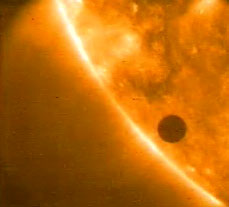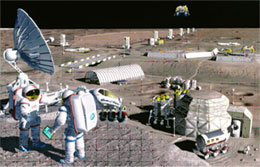The leading edge of the March 6 coronal mass ejection, or CME, reached NASA’s Advanced Composition Explorer, or ACE satellite at 5:42 a.m. EST this morning. ACE sits just outside of Earth’s magnetic environment, the magnetosphere. As magnetic fields from the CMEs connected up to the magnetosphere, instruments on Earth began to measure changes in our planet’s magnetic fields – indicating the onset of a geomagnetic storm.
NASA models using data from the Solar Terrestrial Relations Observatory, or STEREO, and the Solar Heliospheric Observatory, or SOHO have now provided more information about the two CMEs associated with the March 6 flares. The first is traveling faster than 1,300 miles per second; the second more than 1,100 miles per second. NASA’s models predict that the CMEs will impact both Earth and Mars, as well as pass by several NASA spacecraft – Messenger, Spitzer, and STEREO-B. The models also predicted that the leading edge of the first CME will reach Earth at about 1:25 a.m. EST on the morning of March 8 (plus or minus 7 hours). Such a CME could result in a severe geomagnetic storm, causing aurora at low latitudes, with possible disruption to high frequency radio communication, global positioning systems (GPS), and power grids.
This movie of the March 6, 2012 X5.4 flare was captured by the Solar Dynamics Observatory (SDO) in the 171 Angstrom wavelength. One of the most dramatic features is the way the entire surface of the sun seems to ripple with the force of the eruption. This movement comes from something called EIT waves – because they were first discovered with the Extreme ultraviolet Imaging Telescope (EIT) on the Solar Heliospheric Observatory. Since SDO captures images every 12 seconds, it has been able to map the full evolution of these waves and confirm that they can travel across the full breadth of the sun. The waves move at over a million miles per hour, zipping from one side of the sun to the other in about an hour. The movie shows two distinct waves. The first seems to spread in all directions; the second is narrower, moving toward the southeast. Such waves are associated with, and perhaps trigger, fast coronal mass ejections, so it is likely that each one is connected to one of the two CMEs that erupted on March 6. Credit: NASA/SDO/AIA |

 If you are attending the 2012
If you are attending the 2012  As part of a series of electronic professional development experiences for educators, the NASA Explorer Schools and Learning Environments and Research Network, or LE&RN, projects are hosting a 60-minute live professional development Web seminar for educators on March 8, 2012, at 8 p.m. EST. Discover how an algebra activity called “Finding Habitable Planets” will help you teach students to use their skills to analyze NASA data. Students learn about the possibility of discovering planets in habitable zones of solar systems.
As part of a series of electronic professional development experiences for educators, the NASA Explorer Schools and Learning Environments and Research Network, or LE&RN, projects are hosting a 60-minute live professional development Web seminar for educators on March 8, 2012, at 8 p.m. EST. Discover how an algebra activity called “Finding Habitable Planets” will help you teach students to use their skills to analyze NASA data. Students learn about the possibility of discovering planets in habitable zones of solar systems.  NASA Explorer Schools and the National Science Teachers Association are hosting a 90-minute live professional development Web seminar this evening, March 7, 2012, at 6:30 p.m. EST. Learn how students can apply their knowledge of vectors to a hypothetical lunar instrument-servicing mission. Information and tools will be provided to help engage students and relate the lesson to their background knowledge. Participants will collaborate about ways to adapt and modify the problem.
NASA Explorer Schools and the National Science Teachers Association are hosting a 90-minute live professional development Web seminar this evening, March 7, 2012, at 6:30 p.m. EST. Learn how students can apply their knowledge of vectors to a hypothetical lunar instrument-servicing mission. Information and tools will be provided to help engage students and relate the lesson to their background knowledge. Participants will collaborate about ways to adapt and modify the problem.